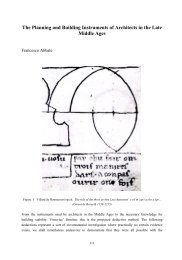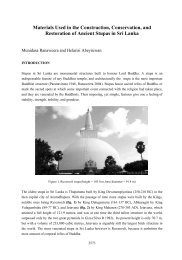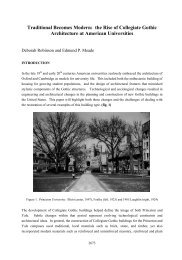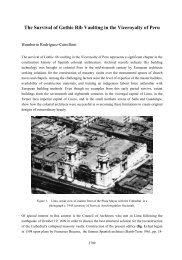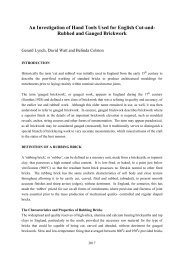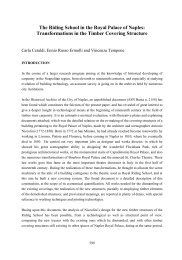Diagrams of a Universal System of Construction in
Diagrams of a Universal System of Construction in
Diagrams of a Universal System of Construction in
You also want an ePaper? Increase the reach of your titles
YUMPU automatically turns print PDFs into web optimized ePapers that Google loves.
y Reyner Banham <strong>in</strong> say<strong>in</strong>g: “we can ask ourselves if it was precisely <strong>in</strong> the design <strong>of</strong> details the<br />
responsibility for the disaster” (Banham 1986, pp. 28-29).<br />
For Kenneth Frampton, <strong>in</strong>stead, the failure was related with lack <strong>of</strong> fund<strong>in</strong>g and socio- cultural<br />
conditions:<br />
It is licit to suppose that two factors had contributed <strong>in</strong> a decisive way to the failure <strong>of</strong> the<br />
General Panel <strong>System</strong>; the first related to the socio- cultural problem <strong>of</strong> ‘accessibility’;<br />
the second com<strong>in</strong>g from the derived lack <strong>of</strong> adequate fund<strong>in</strong>g. Wachsmann avoided any<br />
iconographic element commonly associated to the image <strong>of</strong> a house<br />
(Frampton 1988, p. 43).<br />
For Frampton, the reasons <strong>of</strong> failure were not related <strong>in</strong> any sense to the technology or the<br />
complexity <strong>of</strong> details. It was rather connected to the struggle between modern architectural<br />
expression and people’s social expectations. For him, its failure was a real loss s<strong>in</strong>ce a generalized<br />
adoption <strong>of</strong> the General Panel House would have provided the American suburbia levels <strong>of</strong><br />
urbanity much more elevated than those achieved <strong>in</strong> the last four decades (1988, p. 43). Noth<strong>in</strong>g<br />
could be more distant from Banham’s understand<strong>in</strong>g, when propos<strong>in</strong>g that the General Panel House<br />
was “…a dwell<strong>in</strong>g- concept <strong>of</strong> the utmost banality” (Banham 1996, p. 53).<br />
In one way or another, the failure <strong>of</strong> the system is not <strong>in</strong> doubt. It was seen sometimes as a problem<br />
<strong>of</strong> fund<strong>in</strong>g and expression (Frampton), or as a matter <strong>of</strong> technical sophistication (Herbert); or as the<br />
natural outcome <strong>of</strong> a solution com<strong>in</strong>g from an <strong>in</strong>tellectual attitude that was fundamentally wrong<br />
(Banham). Interest<strong>in</strong>gly, the debate about the system seems to rema<strong>in</strong> unsolved, as well as<br />
Wachsmann’s reputation is still a matter <strong>of</strong> dispute. A recent issue <strong>of</strong> “Detail Magaz<strong>in</strong>e” (2001) has<br />
portrayed Wachsmann and his General Panel <strong>System</strong> as “enormously successful <strong>in</strong> the post- war<br />
construction period” (Detail 2001, v. 41 Nº 4, p. 627).<br />
REPRESENTATION AND TECHNOLOGY<br />
From the systems <strong>of</strong> representation developed by Wachsmann <strong>in</strong> the form <strong>of</strong> an Erection Manual<br />
and 13 symbolic diagrams, it becomes clear that the General Panel was a modal variation <strong>of</strong> a more<br />
ambitious ideal. He searched for a universal system <strong>of</strong> construction <strong>in</strong> which the Erection Manual<br />
was part <strong>of</strong> the reconfiguration <strong>of</strong> architecture by means <strong>of</strong> assemblage.<br />
The ultimate goal was to create a system <strong>of</strong> construction based <strong>in</strong> a total and universal compatibility<br />
<strong>of</strong> elements. The size and shape <strong>of</strong> the f<strong>in</strong>al build<strong>in</strong>g had to correspond to the comb<strong>in</strong>ation <strong>of</strong><br />
elements throughout simple numerical operations, by add<strong>in</strong>g, subtract<strong>in</strong>g, divid<strong>in</strong>g or multiply<strong>in</strong>g<br />
the measure <strong>of</strong> the <strong>in</strong>itial unit acknowledged as the module. Therefore, f<strong>in</strong>d<strong>in</strong>g the coherence <strong>of</strong><br />
measurement for any possible component was the fundamental task <strong>of</strong> technological research,<br />
160








